Planning Learning Experiences: Early Childhood Education Curriculum
VerifiedAdded on 2023/06/11
|9
|2721
|342
Report
AI Summary
This report provides a detailed overview of early childhood education, emphasizing the importance of curriculum planning, observation, and documentation in fostering child development. It discusses the role of curriculum in defining learning experiences, the significance of observation and documentation in understanding children's behavior and learning patterns, and the methods for analyzing children's learning to provide effective educational resources. The report also highlights the importance of planning learning experiences, identifying children's skills, setting goals, and monitoring progress to ensure holistic development. Furthermore, it touches upon the Erikson’s psychological developmental theory and different types of early childhood curriculum, such as theme-based, activity-based, and inquiry-based, to enhance children's skills and abilities effectively. Desklib provides access to this and many other solved assignments for students.
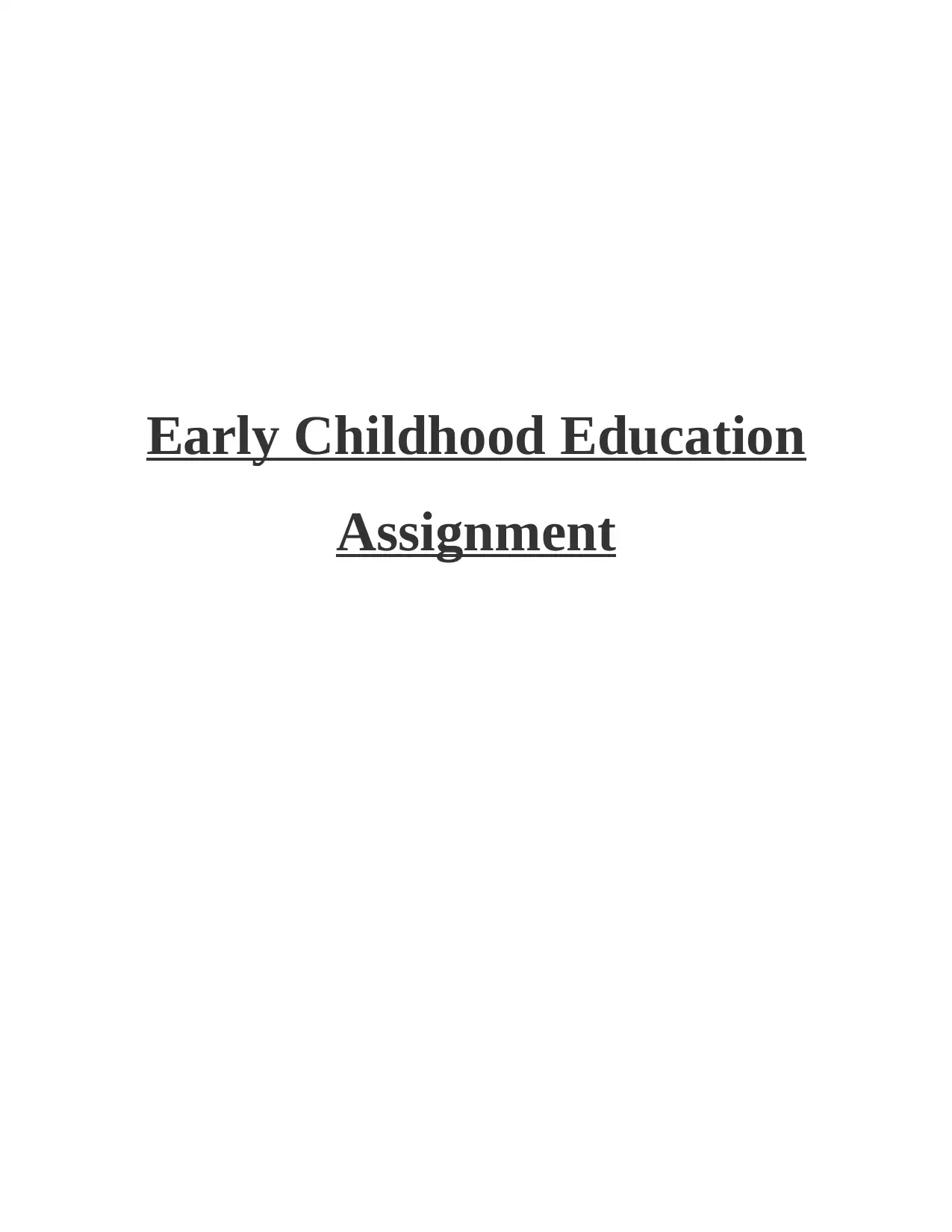
Early Childhood Education
Assignment
Assignment
Paraphrase This Document
Need a fresh take? Get an instant paraphrase of this document with our AI Paraphraser
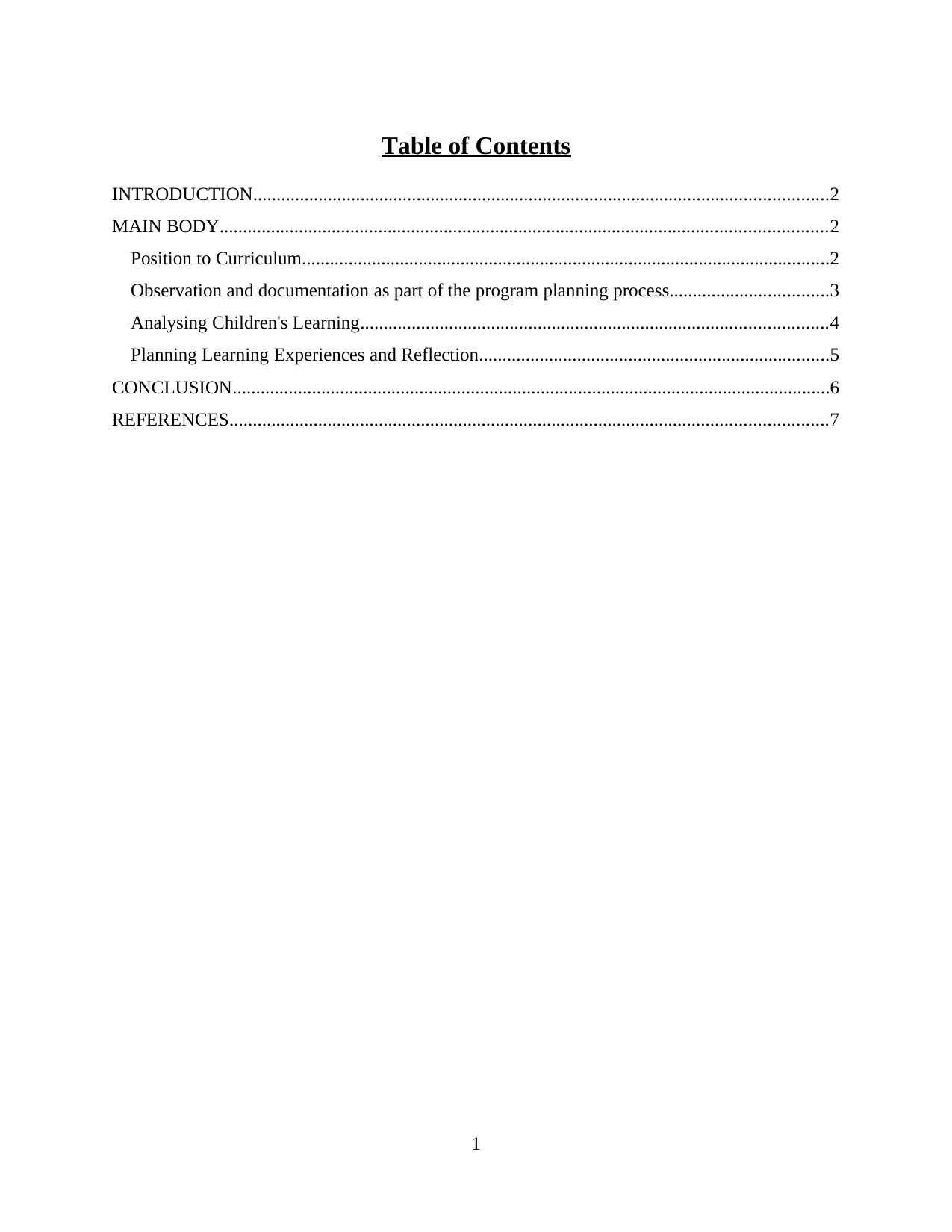
Table of Contents
INTRODUCTION...........................................................................................................................2
MAIN BODY..................................................................................................................................2
Position to Curriculum.................................................................................................................2
Observation and documentation as part of the program planning process..................................3
Analysing Children's Learning....................................................................................................4
Planning Learning Experiences and Reflection...........................................................................5
CONCLUSION................................................................................................................................6
REFERENCES................................................................................................................................7
1
INTRODUCTION...........................................................................................................................2
MAIN BODY..................................................................................................................................2
Position to Curriculum.................................................................................................................2
Observation and documentation as part of the program planning process..................................3
Analysing Children's Learning....................................................................................................4
Planning Learning Experiences and Reflection...........................................................................5
CONCLUSION................................................................................................................................6
REFERENCES................................................................................................................................7
1
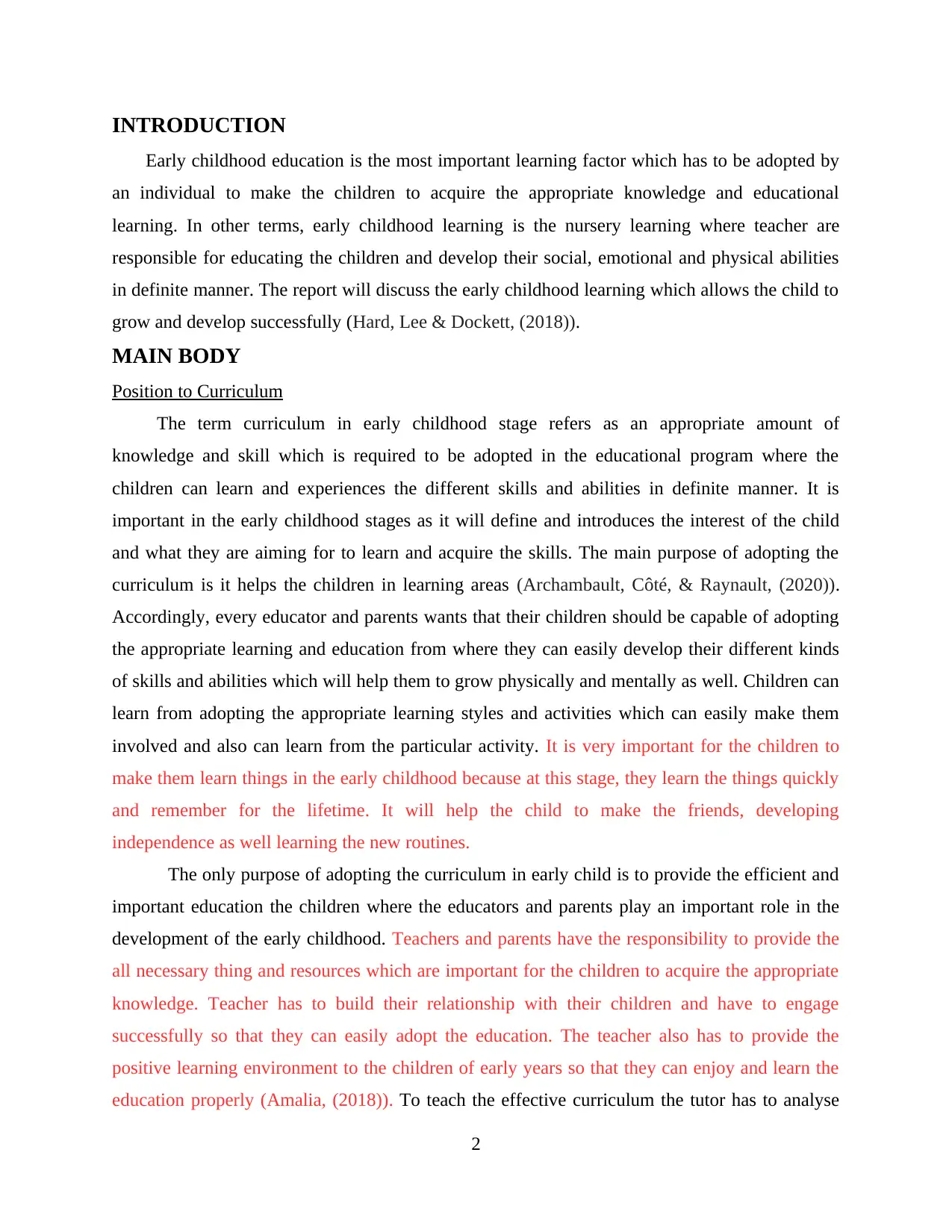
INTRODUCTION
Early childhood education is the most important learning factor which has to be adopted by
an individual to make the children to acquire the appropriate knowledge and educational
learning. In other terms, early childhood learning is the nursery learning where teacher are
responsible for educating the children and develop their social, emotional and physical abilities
in definite manner. The report will discuss the early childhood learning which allows the child to
grow and develop successfully (Hard, Lee & Dockett, (2018)).
MAIN BODY
Position to Curriculum
The term curriculum in early childhood stage refers as an appropriate amount of
knowledge and skill which is required to be adopted in the educational program where the
children can learn and experiences the different skills and abilities in definite manner. It is
important in the early childhood stages as it will define and introduces the interest of the child
and what they are aiming for to learn and acquire the skills. The main purpose of adopting the
curriculum is it helps the children in learning areas (Archambault, Côté, & Raynault, (2020)).
Accordingly, every educator and parents wants that their children should be capable of adopting
the appropriate learning and education from where they can easily develop their different kinds
of skills and abilities which will help them to grow physically and mentally as well. Children can
learn from adopting the appropriate learning styles and activities which can easily make them
involved and also can learn from the particular activity. It is very important for the children to
make them learn things in the early childhood because at this stage, they learn the things quickly
and remember for the lifetime. It will help the child to make the friends, developing
independence as well learning the new routines.
The only purpose of adopting the curriculum in early child is to provide the efficient and
important education the children where the educators and parents play an important role in the
development of the early childhood. Teachers and parents have the responsibility to provide the
all necessary thing and resources which are important for the children to acquire the appropriate
knowledge. Teacher has to build their relationship with their children and have to engage
successfully so that they can easily adopt the education. The teacher also has to provide the
positive learning environment to the children of early years so that they can enjoy and learn the
education properly (Amalia, (2018)). To teach the effective curriculum the tutor has to analyse
2
Early childhood education is the most important learning factor which has to be adopted by
an individual to make the children to acquire the appropriate knowledge and educational
learning. In other terms, early childhood learning is the nursery learning where teacher are
responsible for educating the children and develop their social, emotional and physical abilities
in definite manner. The report will discuss the early childhood learning which allows the child to
grow and develop successfully (Hard, Lee & Dockett, (2018)).
MAIN BODY
Position to Curriculum
The term curriculum in early childhood stage refers as an appropriate amount of
knowledge and skill which is required to be adopted in the educational program where the
children can learn and experiences the different skills and abilities in definite manner. It is
important in the early childhood stages as it will define and introduces the interest of the child
and what they are aiming for to learn and acquire the skills. The main purpose of adopting the
curriculum is it helps the children in learning areas (Archambault, Côté, & Raynault, (2020)).
Accordingly, every educator and parents wants that their children should be capable of adopting
the appropriate learning and education from where they can easily develop their different kinds
of skills and abilities which will help them to grow physically and mentally as well. Children can
learn from adopting the appropriate learning styles and activities which can easily make them
involved and also can learn from the particular activity. It is very important for the children to
make them learn things in the early childhood because at this stage, they learn the things quickly
and remember for the lifetime. It will help the child to make the friends, developing
independence as well learning the new routines.
The only purpose of adopting the curriculum in early child is to provide the efficient and
important education the children where the educators and parents play an important role in the
development of the early childhood. Teachers and parents have the responsibility to provide the
all necessary thing and resources which are important for the children to acquire the appropriate
knowledge. Teacher has to build their relationship with their children and have to engage
successfully so that they can easily adopt the education. The teacher also has to provide the
positive learning environment to the children of early years so that they can enjoy and learn the
education properly (Amalia, (2018)). To teach the effective curriculum the tutor has to analyse
2
⊘ This is a preview!⊘
Do you want full access?
Subscribe today to unlock all pages.

Trusted by 1+ million students worldwide
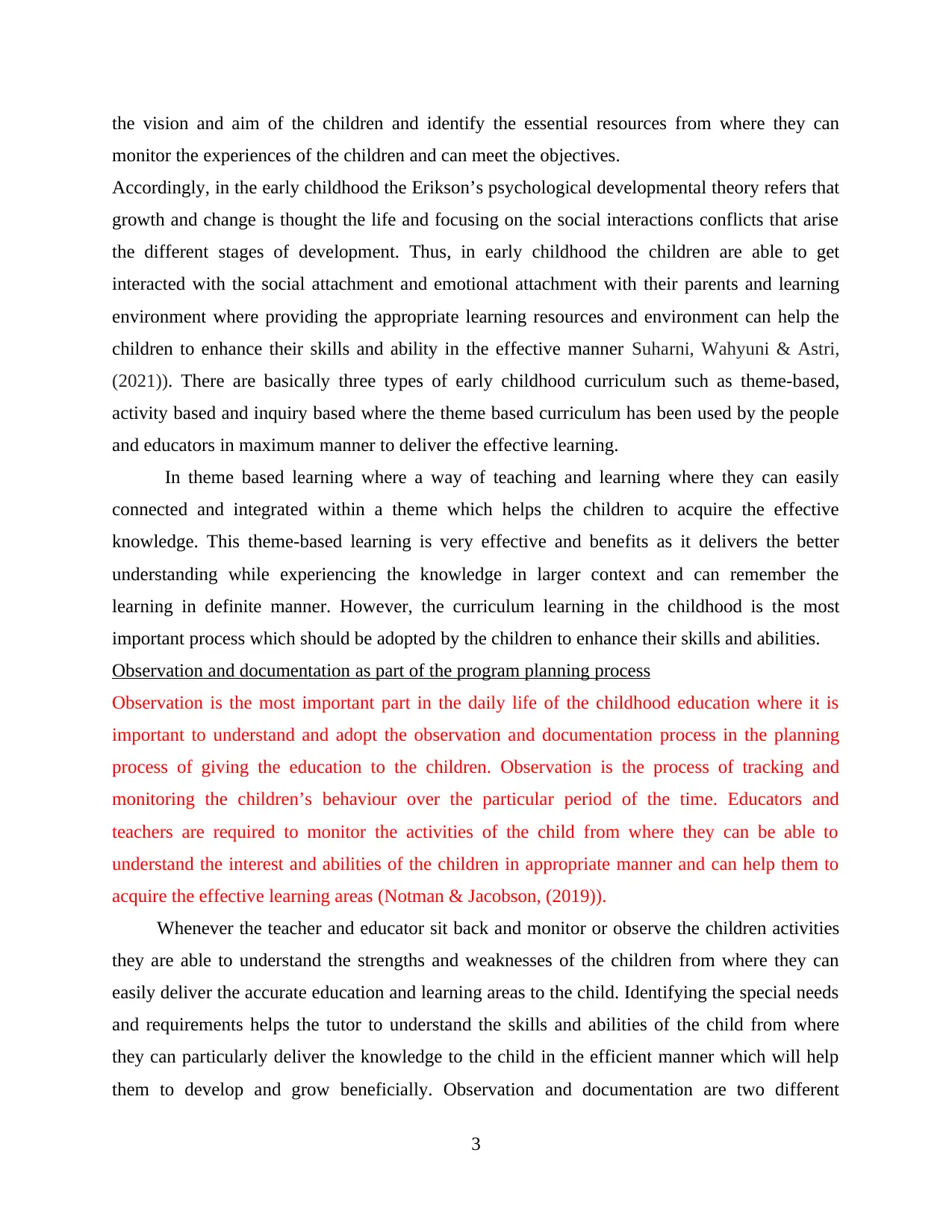
the vision and aim of the children and identify the essential resources from where they can
monitor the experiences of the children and can meet the objectives.
Accordingly, in the early childhood the Erikson’s psychological developmental theory refers that
growth and change is thought the life and focusing on the social interactions conflicts that arise
the different stages of development. Thus, in early childhood the children are able to get
interacted with the social attachment and emotional attachment with their parents and learning
environment where providing the appropriate learning resources and environment can help the
children to enhance their skills and ability in the effective manner Suharni, Wahyuni & Astri,
(2021)). There are basically three types of early childhood curriculum such as theme-based,
activity based and inquiry based where the theme based curriculum has been used by the people
and educators in maximum manner to deliver the effective learning.
In theme based learning where a way of teaching and learning where they can easily
connected and integrated within a theme which helps the children to acquire the effective
knowledge. This theme-based learning is very effective and benefits as it delivers the better
understanding while experiencing the knowledge in larger context and can remember the
learning in definite manner. However, the curriculum learning in the childhood is the most
important process which should be adopted by the children to enhance their skills and abilities.
Observation and documentation as part of the program planning process
Observation is the most important part in the daily life of the childhood education where it is
important to understand and adopt the observation and documentation process in the planning
process of giving the education to the children. Observation is the process of tracking and
monitoring the children’s behaviour over the particular period of the time. Educators and
teachers are required to monitor the activities of the child from where they can be able to
understand the interest and abilities of the children in appropriate manner and can help them to
acquire the effective learning areas (Notman & Jacobson, (2019)).
Whenever the teacher and educator sit back and monitor or observe the children activities
they are able to understand the strengths and weaknesses of the children from where they can
easily deliver the accurate education and learning areas to the child. Identifying the special needs
and requirements helps the tutor to understand the skills and abilities of the child from where
they can particularly deliver the knowledge to the child in the efficient manner which will help
them to develop and grow beneficially. Observation and documentation are two different
3
monitor the experiences of the children and can meet the objectives.
Accordingly, in the early childhood the Erikson’s psychological developmental theory refers that
growth and change is thought the life and focusing on the social interactions conflicts that arise
the different stages of development. Thus, in early childhood the children are able to get
interacted with the social attachment and emotional attachment with their parents and learning
environment where providing the appropriate learning resources and environment can help the
children to enhance their skills and ability in the effective manner Suharni, Wahyuni & Astri,
(2021)). There are basically three types of early childhood curriculum such as theme-based,
activity based and inquiry based where the theme based curriculum has been used by the people
and educators in maximum manner to deliver the effective learning.
In theme based learning where a way of teaching and learning where they can easily
connected and integrated within a theme which helps the children to acquire the effective
knowledge. This theme-based learning is very effective and benefits as it delivers the better
understanding while experiencing the knowledge in larger context and can remember the
learning in definite manner. However, the curriculum learning in the childhood is the most
important process which should be adopted by the children to enhance their skills and abilities.
Observation and documentation as part of the program planning process
Observation is the most important part in the daily life of the childhood education where it is
important to understand and adopt the observation and documentation process in the planning
process of giving the education to the children. Observation is the process of tracking and
monitoring the children’s behaviour over the particular period of the time. Educators and
teachers are required to monitor the activities of the child from where they can be able to
understand the interest and abilities of the children in appropriate manner and can help them to
acquire the effective learning areas (Notman & Jacobson, (2019)).
Whenever the teacher and educator sit back and monitor or observe the children activities
they are able to understand the strengths and weaknesses of the children from where they can
easily deliver the accurate education and learning areas to the child. Identifying the special needs
and requirements helps the tutor to understand the skills and abilities of the child from where
they can particularly deliver the knowledge to the child in the efficient manner which will help
them to develop and grow beneficially. Observation and documentation are two different
3
Paraphrase This Document
Need a fresh take? Get an instant paraphrase of this document with our AI Paraphraser
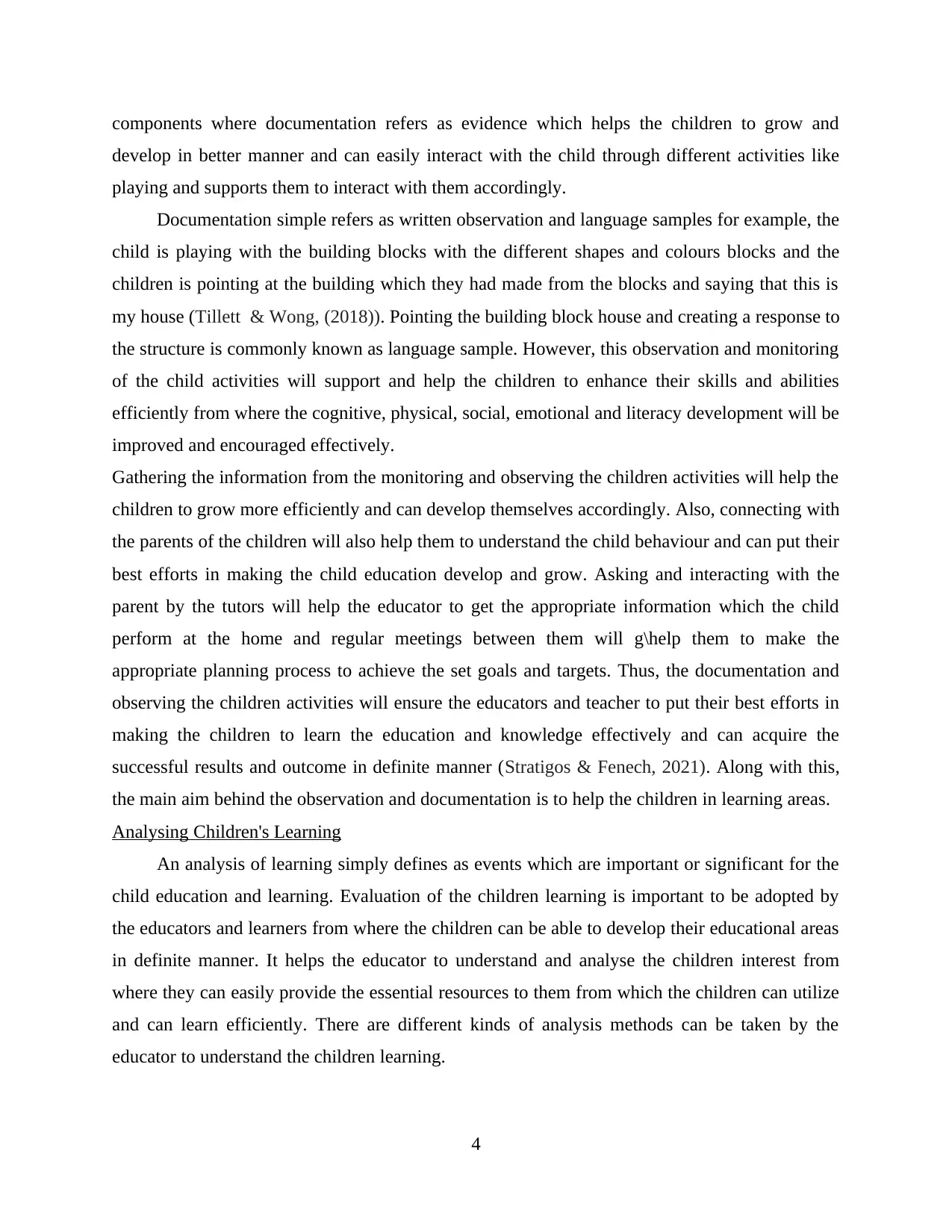
components where documentation refers as evidence which helps the children to grow and
develop in better manner and can easily interact with the child through different activities like
playing and supports them to interact with them accordingly.
Documentation simple refers as written observation and language samples for example, the
child is playing with the building blocks with the different shapes and colours blocks and the
children is pointing at the building which they had made from the blocks and saying that this is
my house (Tillett & Wong, (2018)). Pointing the building block house and creating a response to
the structure is commonly known as language sample. However, this observation and monitoring
of the child activities will support and help the children to enhance their skills and abilities
efficiently from where the cognitive, physical, social, emotional and literacy development will be
improved and encouraged effectively.
Gathering the information from the monitoring and observing the children activities will help the
children to grow more efficiently and can develop themselves accordingly. Also, connecting with
the parents of the children will also help them to understand the child behaviour and can put their
best efforts in making the child education develop and grow. Asking and interacting with the
parent by the tutors will help the educator to get the appropriate information which the child
perform at the home and regular meetings between them will g\help them to make the
appropriate planning process to achieve the set goals and targets. Thus, the documentation and
observing the children activities will ensure the educators and teacher to put their best efforts in
making the children to learn the education and knowledge effectively and can acquire the
successful results and outcome in definite manner (Stratigos & Fenech, 2021). Along with this,
the main aim behind the observation and documentation is to help the children in learning areas.
Analysing Children's Learning
An analysis of learning simply defines as events which are important or significant for the
child education and learning. Evaluation of the children learning is important to be adopted by
the educators and learners from where the children can be able to develop their educational areas
in definite manner. It helps the educator to understand and analyse the children interest from
where they can easily provide the essential resources to them from which the children can utilize
and can learn efficiently. There are different kinds of analysis methods can be taken by the
educator to understand the children learning.
4
develop in better manner and can easily interact with the child through different activities like
playing and supports them to interact with them accordingly.
Documentation simple refers as written observation and language samples for example, the
child is playing with the building blocks with the different shapes and colours blocks and the
children is pointing at the building which they had made from the blocks and saying that this is
my house (Tillett & Wong, (2018)). Pointing the building block house and creating a response to
the structure is commonly known as language sample. However, this observation and monitoring
of the child activities will support and help the children to enhance their skills and abilities
efficiently from where the cognitive, physical, social, emotional and literacy development will be
improved and encouraged effectively.
Gathering the information from the monitoring and observing the children activities will help the
children to grow more efficiently and can develop themselves accordingly. Also, connecting with
the parents of the children will also help them to understand the child behaviour and can put their
best efforts in making the child education develop and grow. Asking and interacting with the
parent by the tutors will help the educator to get the appropriate information which the child
perform at the home and regular meetings between them will g\help them to make the
appropriate planning process to achieve the set goals and targets. Thus, the documentation and
observing the children activities will ensure the educators and teacher to put their best efforts in
making the children to learn the education and knowledge effectively and can acquire the
successful results and outcome in definite manner (Stratigos & Fenech, 2021). Along with this,
the main aim behind the observation and documentation is to help the children in learning areas.
Analysing Children's Learning
An analysis of learning simply defines as events which are important or significant for the
child education and learning. Evaluation of the children learning is important to be adopted by
the educators and learners from where the children can be able to develop their educational areas
in definite manner. It helps the educator to understand and analyse the children interest from
where they can easily provide the essential resources to them from which the children can utilize
and can learn efficiently. There are different kinds of analysis methods can be taken by the
educator to understand the children learning.
4
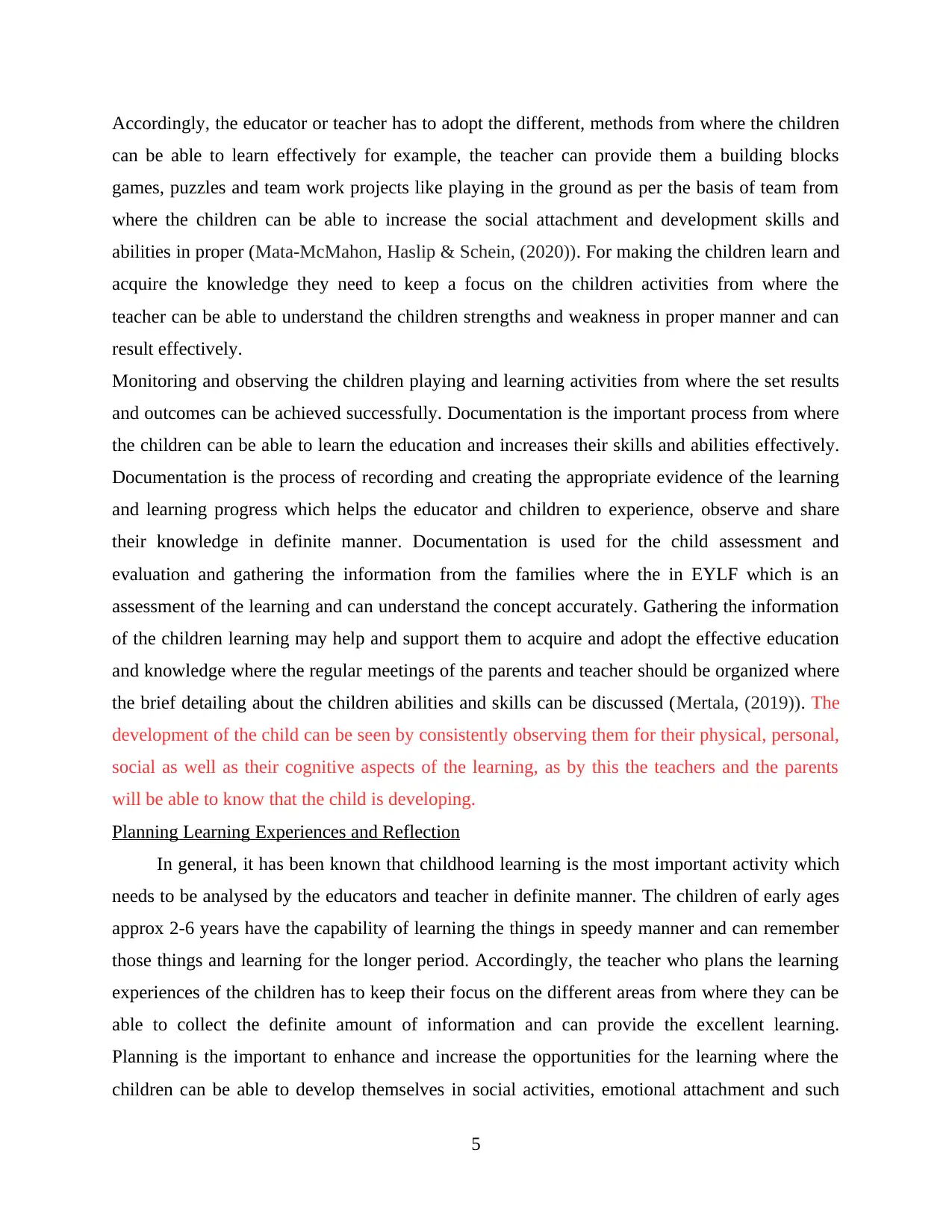
Accordingly, the educator or teacher has to adopt the different, methods from where the children
can be able to learn effectively for example, the teacher can provide them a building blocks
games, puzzles and team work projects like playing in the ground as per the basis of team from
where the children can be able to increase the social attachment and development skills and
abilities in proper (Mata-McMahon, Haslip & Schein, (2020)). For making the children learn and
acquire the knowledge they need to keep a focus on the children activities from where the
teacher can be able to understand the children strengths and weakness in proper manner and can
result effectively.
Monitoring and observing the children playing and learning activities from where the set results
and outcomes can be achieved successfully. Documentation is the important process from where
the children can be able to learn the education and increases their skills and abilities effectively.
Documentation is the process of recording and creating the appropriate evidence of the learning
and learning progress which helps the educator and children to experience, observe and share
their knowledge in definite manner. Documentation is used for the child assessment and
evaluation and gathering the information from the families where the in EYLF which is an
assessment of the learning and can understand the concept accurately. Gathering the information
of the children learning may help and support them to acquire and adopt the effective education
and knowledge where the regular meetings of the parents and teacher should be organized where
the brief detailing about the children abilities and skills can be discussed (Mertala, (2019)). The
development of the child can be seen by consistently observing them for their physical, personal,
social as well as their cognitive aspects of the learning, as by this the teachers and the parents
will be able to know that the child is developing.
Planning Learning Experiences and Reflection
In general, it has been known that childhood learning is the most important activity which
needs to be analysed by the educators and teacher in definite manner. The children of early ages
approx 2-6 years have the capability of learning the things in speedy manner and can remember
those things and learning for the longer period. Accordingly, the teacher who plans the learning
experiences of the children has to keep their focus on the different areas from where they can be
able to collect the definite amount of information and can provide the excellent learning.
Planning is the important to enhance and increase the opportunities for the learning where the
children can be able to develop themselves in social activities, emotional attachment and such
5
can be able to learn effectively for example, the teacher can provide them a building blocks
games, puzzles and team work projects like playing in the ground as per the basis of team from
where the children can be able to increase the social attachment and development skills and
abilities in proper (Mata-McMahon, Haslip & Schein, (2020)). For making the children learn and
acquire the knowledge they need to keep a focus on the children activities from where the
teacher can be able to understand the children strengths and weakness in proper manner and can
result effectively.
Monitoring and observing the children playing and learning activities from where the set results
and outcomes can be achieved successfully. Documentation is the important process from where
the children can be able to learn the education and increases their skills and abilities effectively.
Documentation is the process of recording and creating the appropriate evidence of the learning
and learning progress which helps the educator and children to experience, observe and share
their knowledge in definite manner. Documentation is used for the child assessment and
evaluation and gathering the information from the families where the in EYLF which is an
assessment of the learning and can understand the concept accurately. Gathering the information
of the children learning may help and support them to acquire and adopt the effective education
and knowledge where the regular meetings of the parents and teacher should be organized where
the brief detailing about the children abilities and skills can be discussed (Mertala, (2019)). The
development of the child can be seen by consistently observing them for their physical, personal,
social as well as their cognitive aspects of the learning, as by this the teachers and the parents
will be able to know that the child is developing.
Planning Learning Experiences and Reflection
In general, it has been known that childhood learning is the most important activity which
needs to be analysed by the educators and teacher in definite manner. The children of early ages
approx 2-6 years have the capability of learning the things in speedy manner and can remember
those things and learning for the longer period. Accordingly, the teacher who plans the learning
experiences of the children has to keep their focus on the different areas from where they can be
able to collect the definite amount of information and can provide the excellent learning.
Planning is the important to enhance and increase the opportunities for the learning where the
children can be able to develop themselves in social activities, emotional attachment and such
5
⊘ This is a preview!⊘
Do you want full access?
Subscribe today to unlock all pages.

Trusted by 1+ million students worldwide
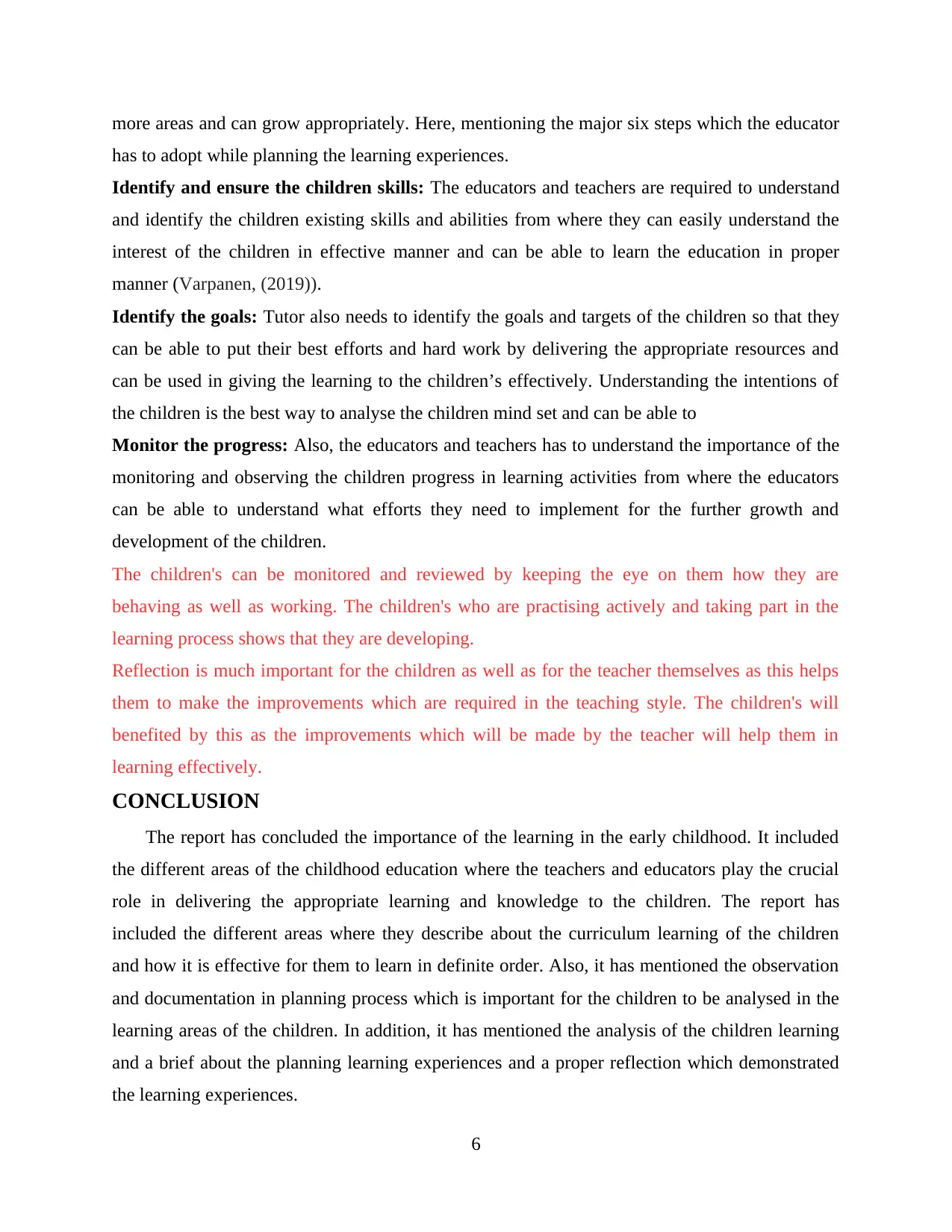
more areas and can grow appropriately. Here, mentioning the major six steps which the educator
has to adopt while planning the learning experiences.
Identify and ensure the children skills: The educators and teachers are required to understand
and identify the children existing skills and abilities from where they can easily understand the
interest of the children in effective manner and can be able to learn the education in proper
manner (Varpanen, (2019)).
Identify the goals: Tutor also needs to identify the goals and targets of the children so that they
can be able to put their best efforts and hard work by delivering the appropriate resources and
can be used in giving the learning to the children’s effectively. Understanding the intentions of
the children is the best way to analyse the children mind set and can be able to
Monitor the progress: Also, the educators and teachers has to understand the importance of the
monitoring and observing the children progress in learning activities from where the educators
can be able to understand what efforts they need to implement for the further growth and
development of the children.
The children's can be monitored and reviewed by keeping the eye on them how they are
behaving as well as working. The children's who are practising actively and taking part in the
learning process shows that they are developing.
Reflection is much important for the children as well as for the teacher themselves as this helps
them to make the improvements which are required in the teaching style. The children's will
benefited by this as the improvements which will be made by the teacher will help them in
learning effectively.
CONCLUSION
The report has concluded the importance of the learning in the early childhood. It included
the different areas of the childhood education where the teachers and educators play the crucial
role in delivering the appropriate learning and knowledge to the children. The report has
included the different areas where they describe about the curriculum learning of the children
and how it is effective for them to learn in definite order. Also, it has mentioned the observation
and documentation in planning process which is important for the children to be analysed in the
learning areas of the children. In addition, it has mentioned the analysis of the children learning
and a brief about the planning learning experiences and a proper reflection which demonstrated
the learning experiences.
6
has to adopt while planning the learning experiences.
Identify and ensure the children skills: The educators and teachers are required to understand
and identify the children existing skills and abilities from where they can easily understand the
interest of the children in effective manner and can be able to learn the education in proper
manner (Varpanen, (2019)).
Identify the goals: Tutor also needs to identify the goals and targets of the children so that they
can be able to put their best efforts and hard work by delivering the appropriate resources and
can be used in giving the learning to the children’s effectively. Understanding the intentions of
the children is the best way to analyse the children mind set and can be able to
Monitor the progress: Also, the educators and teachers has to understand the importance of the
monitoring and observing the children progress in learning activities from where the educators
can be able to understand what efforts they need to implement for the further growth and
development of the children.
The children's can be monitored and reviewed by keeping the eye on them how they are
behaving as well as working. The children's who are practising actively and taking part in the
learning process shows that they are developing.
Reflection is much important for the children as well as for the teacher themselves as this helps
them to make the improvements which are required in the teaching style. The children's will
benefited by this as the improvements which will be made by the teacher will help them in
learning effectively.
CONCLUSION
The report has concluded the importance of the learning in the early childhood. It included
the different areas of the childhood education where the teachers and educators play the crucial
role in delivering the appropriate learning and knowledge to the children. The report has
included the different areas where they describe about the curriculum learning of the children
and how it is effective for them to learn in definite order. Also, it has mentioned the observation
and documentation in planning process which is important for the children to be analysed in the
learning areas of the children. In addition, it has mentioned the analysis of the children learning
and a brief about the planning learning experiences and a proper reflection which demonstrated
the learning experiences.
6
Paraphrase This Document
Need a fresh take? Get an instant paraphrase of this document with our AI Paraphraser
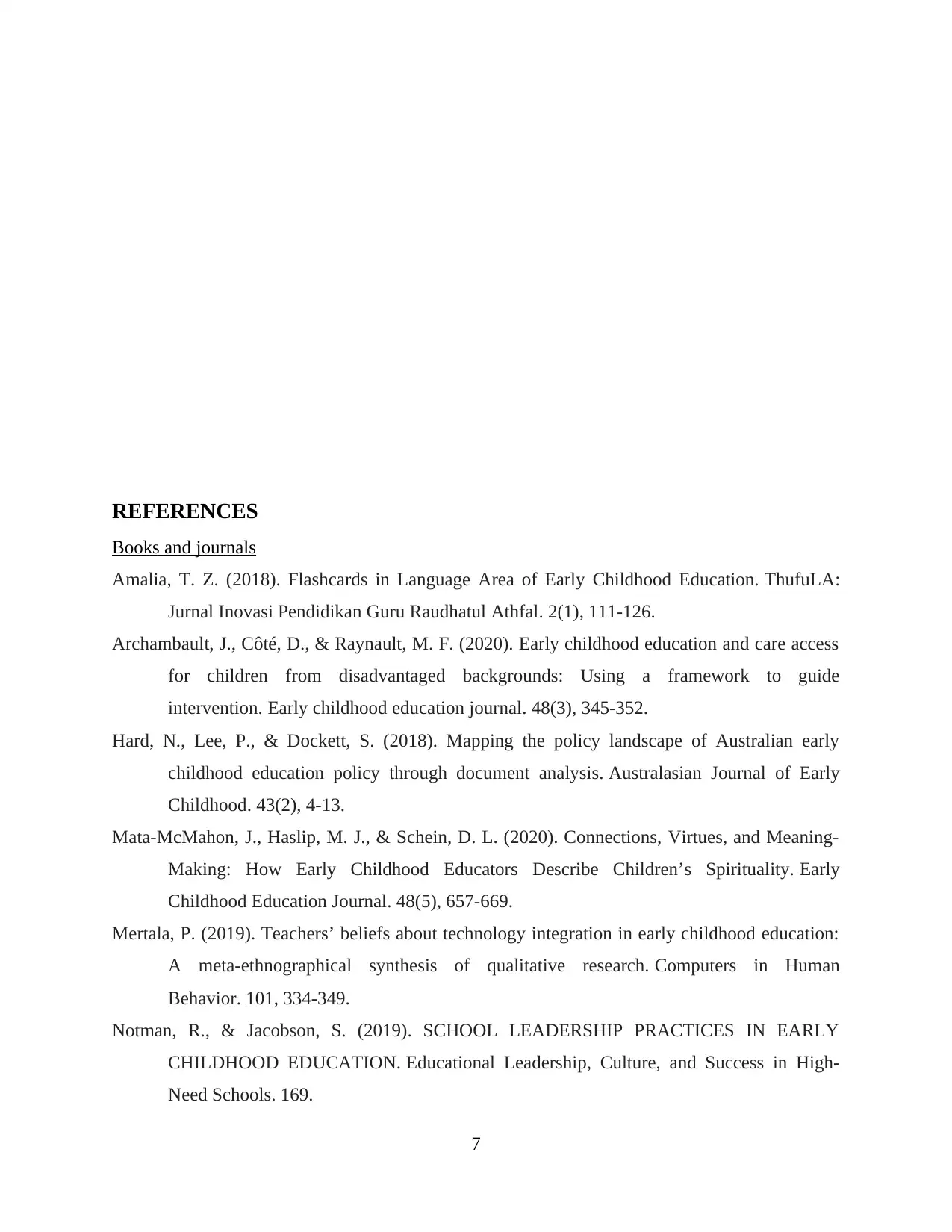
REFERENCES
Books and journals
Amalia, T. Z. (2018). Flashcards in Language Area of Early Childhood Education. ThufuLA:
Jurnal Inovasi Pendidikan Guru Raudhatul Athfal. 2(1), 111-126.
Archambault, J., Côté, D., & Raynault, M. F. (2020). Early childhood education and care access
for children from disadvantaged backgrounds: Using a framework to guide
intervention. Early childhood education journal. 48(3), 345-352.
Hard, N., Lee, P., & Dockett, S. (2018). Mapping the policy landscape of Australian early
childhood education policy through document analysis. Australasian Journal of Early
Childhood. 43(2), 4-13.
Mata-McMahon, J., Haslip, M. J., & Schein, D. L. (2020). Connections, Virtues, and Meaning-
Making: How Early Childhood Educators Describe Children’s Spirituality. Early
Childhood Education Journal. 48(5), 657-669.
Mertala, P. (2019). Teachers’ beliefs about technology integration in early childhood education:
A meta-ethnographical synthesis of qualitative research. Computers in Human
Behavior. 101, 334-349.
Notman, R., & Jacobson, S. (2019). SCHOOL LEADERSHIP PRACTICES IN EARLY
CHILDHOOD EDUCATION. Educational Leadership, Culture, and Success in High-
Need Schools. 169.
7
Books and journals
Amalia, T. Z. (2018). Flashcards in Language Area of Early Childhood Education. ThufuLA:
Jurnal Inovasi Pendidikan Guru Raudhatul Athfal. 2(1), 111-126.
Archambault, J., Côté, D., & Raynault, M. F. (2020). Early childhood education and care access
for children from disadvantaged backgrounds: Using a framework to guide
intervention. Early childhood education journal. 48(3), 345-352.
Hard, N., Lee, P., & Dockett, S. (2018). Mapping the policy landscape of Australian early
childhood education policy through document analysis. Australasian Journal of Early
Childhood. 43(2), 4-13.
Mata-McMahon, J., Haslip, M. J., & Schein, D. L. (2020). Connections, Virtues, and Meaning-
Making: How Early Childhood Educators Describe Children’s Spirituality. Early
Childhood Education Journal. 48(5), 657-669.
Mertala, P. (2019). Teachers’ beliefs about technology integration in early childhood education:
A meta-ethnographical synthesis of qualitative research. Computers in Human
Behavior. 101, 334-349.
Notman, R., & Jacobson, S. (2019). SCHOOL LEADERSHIP PRACTICES IN EARLY
CHILDHOOD EDUCATION. Educational Leadership, Culture, and Success in High-
Need Schools. 169.
7
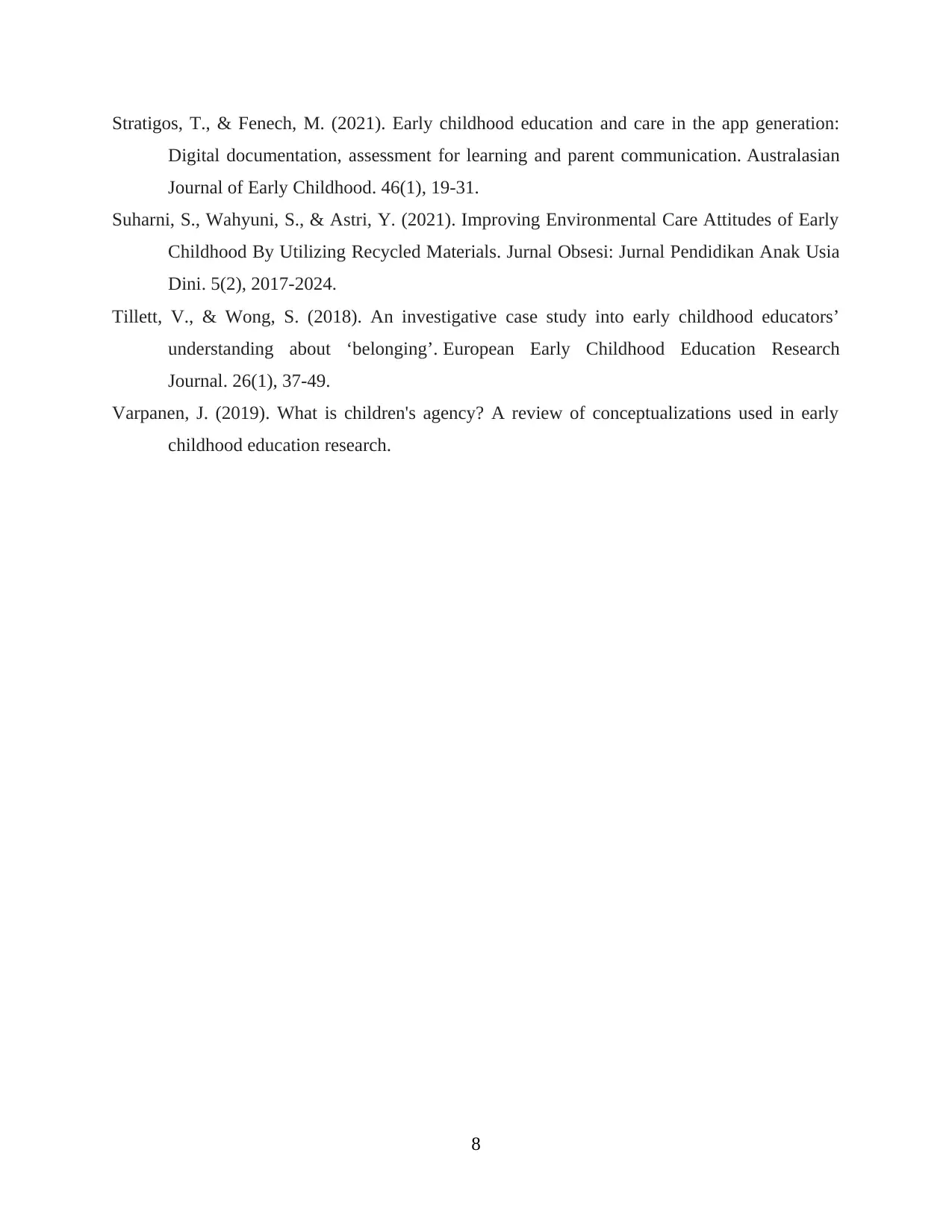
Stratigos, T., & Fenech, M. (2021). Early childhood education and care in the app generation:
Digital documentation, assessment for learning and parent communication. Australasian
Journal of Early Childhood. 46(1), 19-31.
Suharni, S., Wahyuni, S., & Astri, Y. (2021). Improving Environmental Care Attitudes of Early
Childhood By Utilizing Recycled Materials. Jurnal Obsesi: Jurnal Pendidikan Anak Usia
Dini. 5(2), 2017-2024.
Tillett, V., & Wong, S. (2018). An investigative case study into early childhood educators’
understanding about ‘belonging’. European Early Childhood Education Research
Journal. 26(1), 37-49.
Varpanen, J. (2019). What is children's agency? A review of conceptualizations used in early
childhood education research.
8
Digital documentation, assessment for learning and parent communication. Australasian
Journal of Early Childhood. 46(1), 19-31.
Suharni, S., Wahyuni, S., & Astri, Y. (2021). Improving Environmental Care Attitudes of Early
Childhood By Utilizing Recycled Materials. Jurnal Obsesi: Jurnal Pendidikan Anak Usia
Dini. 5(2), 2017-2024.
Tillett, V., & Wong, S. (2018). An investigative case study into early childhood educators’
understanding about ‘belonging’. European Early Childhood Education Research
Journal. 26(1), 37-49.
Varpanen, J. (2019). What is children's agency? A review of conceptualizations used in early
childhood education research.
8
⊘ This is a preview!⊘
Do you want full access?
Subscribe today to unlock all pages.

Trusted by 1+ million students worldwide
1 out of 9
Related Documents
Your All-in-One AI-Powered Toolkit for Academic Success.
+13062052269
info@desklib.com
Available 24*7 on WhatsApp / Email
![[object Object]](/_next/static/media/star-bottom.7253800d.svg)
Unlock your academic potential
Copyright © 2020–2025 A2Z Services. All Rights Reserved. Developed and managed by ZUCOL.





